【注意】最后更新于 March 2, 2019,文中内容可能已过时,请谨慎使用。
一、ByteBuf工作原理
1.为什么Netty扩展NIO中ByteBuffer类?
主要原因ByteBuffer设计不足几点:
-
ByteBuffer一旦分配完成,长度固定,不支持动态扩展和收缩,当需要编码的POJO对象大于分配容量时发生索引越界异常;
-
ByteBuffer的原理就是capacity(容量),position(位置),limit(限制)三个变量,来创建ByteBuffer方式’ByteBuffer.allocate(8)',现在capacity=8,position=0,limit=8,
进行写操作,写两个字节,现在capacity=8,position=2,limit=8;变成读模式,手动调用flip()方法才能读到数据,现在capacity=8,position=0,limit=2;手动触发flip() 才能继续读数据,对API不了解很容易出错。
-
ByteBuffer的API功能有限!高级API自己扩展实现。
2.ByteBuf工作原理
ByteBuf提供了两个指针变量来支持连续的读写操作 - readerIndex用于读操作,writerIndex用于write操作。下图显示了如何通过两个指针
将缓冲区分割成三个区域:
1
2
3
4
5
6
7
|
+-------------------+------------------+------------------+
| discardable bytes | readable bytes | writable bytes |
| | (CONTENT) | |
+-------------------+------------------+------------------+
| | | |
0 <= readerIndex <= writerIndex <= capacity
|
(1).读取(实际内容)
这部分是存储实际数据。方法名称以read或skip开头的任何操API作将获取或跳过当前readerIndex中的数据,并将其增加读取字节数。
如果读操作的参数也是一个ByteBuf,并且没有指定目标索引,则指定ByteBuf的writerIndex会一起增加
如果没有足够的内容,则引发IndexOutOfBoundsException。新分配,打包或复制缓冲区的readerIndex的默认值为0。
1
2
3
4
5
|
// Iterates the readable bytes of a buffer.
ByteBuf buffer = ...;
while (buffer.isReadable()) {
System.out.println(buffer.readByte());
}
|
(2).写
这部分是一个未定义的空间,需要填写。名称以write开头的任何操作将在当前writerIndex处写入数据,并将其增加写入字节数。
如果写操作的参数也是ByteBuf,并且没有指定源索引,则指定ByteBuf 的readerIndex会一起增加。
如果没有足够的可写字节,则引发IndexOutOfBoundsException。新分配的缓冲区的writerIndex的默认值是0.
包装或复制的缓冲区的writerIndex的默认值是缓冲区的容量。
1
2
3
4
5
|
// Fills the writable bytes of a buffer with random integers.
ByteBuf buffer = ...;
while (buffer.maxWritableBytes() >= 4) {
buffer.writeInt(random.nextInt());
}
|
(3).Discardable bytes
这个段包含已经被读取操作读取的字节。最初,这个段的大小是0,但是随着读取操作的执行,它的大小增加到了writerIndex。
读取的字节可以通过调用discardReadBytes()来回收未使用的区域,如下图所示:
1
2
3
4
5
6
7
8
9
10
11
12
13
14
15
16
17
|
BEFORE discardReadBytes()
+-------------------+------------------+------------------+
| discardable bytes | readable bytes | writable bytes |
+-------------------+------------------+------------------+
| | | |
0 <= readerIndex <= writerIndex <= capacity
AFTER discardReadBytes()
+------------------+--------------------------------------+
| readable bytes | writable bytes (got more space) |
+------------------+--------------------------------------+
| | |
readerIndex (0) <= writerIndex (decreased) <= capacity
|
请注意,在调用discardReadBytes()之后,不能保证可写字节的内容。可写入的字节在大多数情况下不会被移动,甚至可能被完全不同的数据填充,这取决于底层的缓冲区实现。
(4).清除
您可以通过调用clear()将readerIndex和writerIndex设置为0。它不清除缓冲区内容(例如,用0填充),但只是清除了两个指针。
另请注意,此操作的语义与Buffer.clear()不同。
1
2
3
4
5
6
7
8
9
10
11
12
13
14
15
16
17
|
BEFORE clear()
+-------------------+------------------+------------------+
| discardable bytes | readable bytes | writable bytes |
+-------------------+------------------+------------------+
| | | |
0 <= readerIndex <= writerIndex <= capacity
AFTER clear()
+---------------------------------------------------------+
| writable bytes (got more space) |
+---------------------------------------------------------+
| |
0 = readerIndex = writerIndex <= capacity
|
二、ByteBuf的API说明
ByteBuf抽象方法很多,这里只做具体方法做说明。

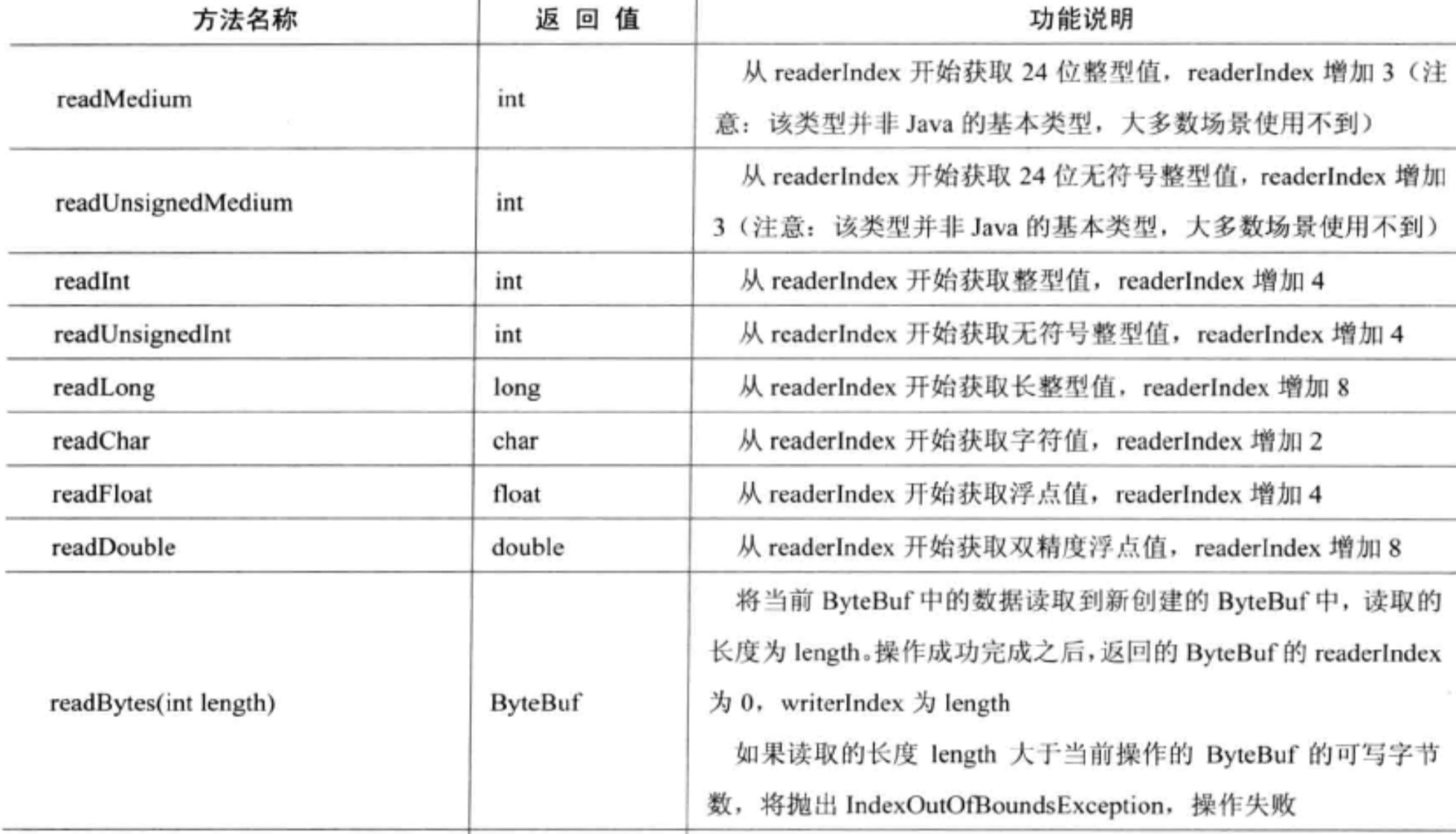
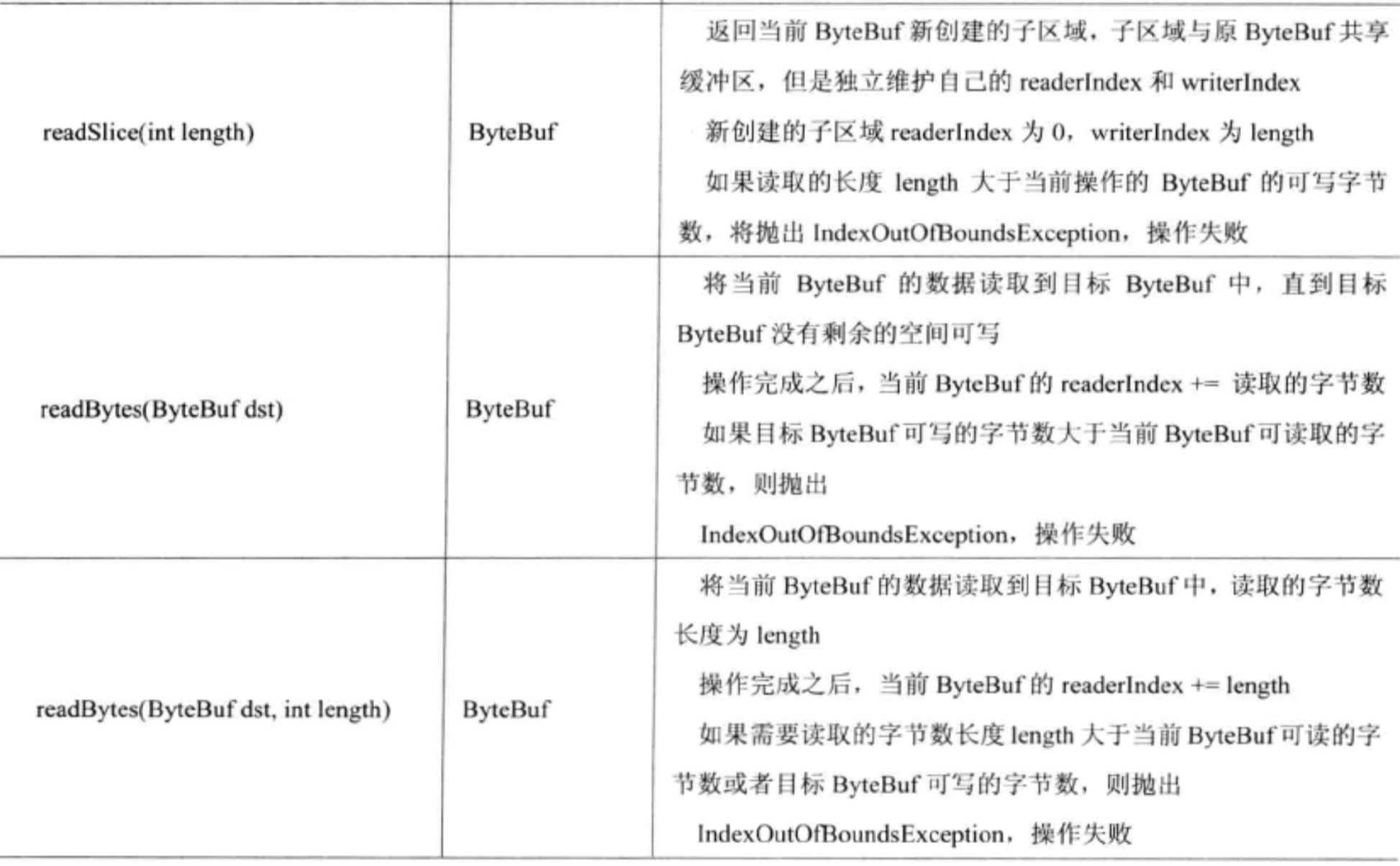
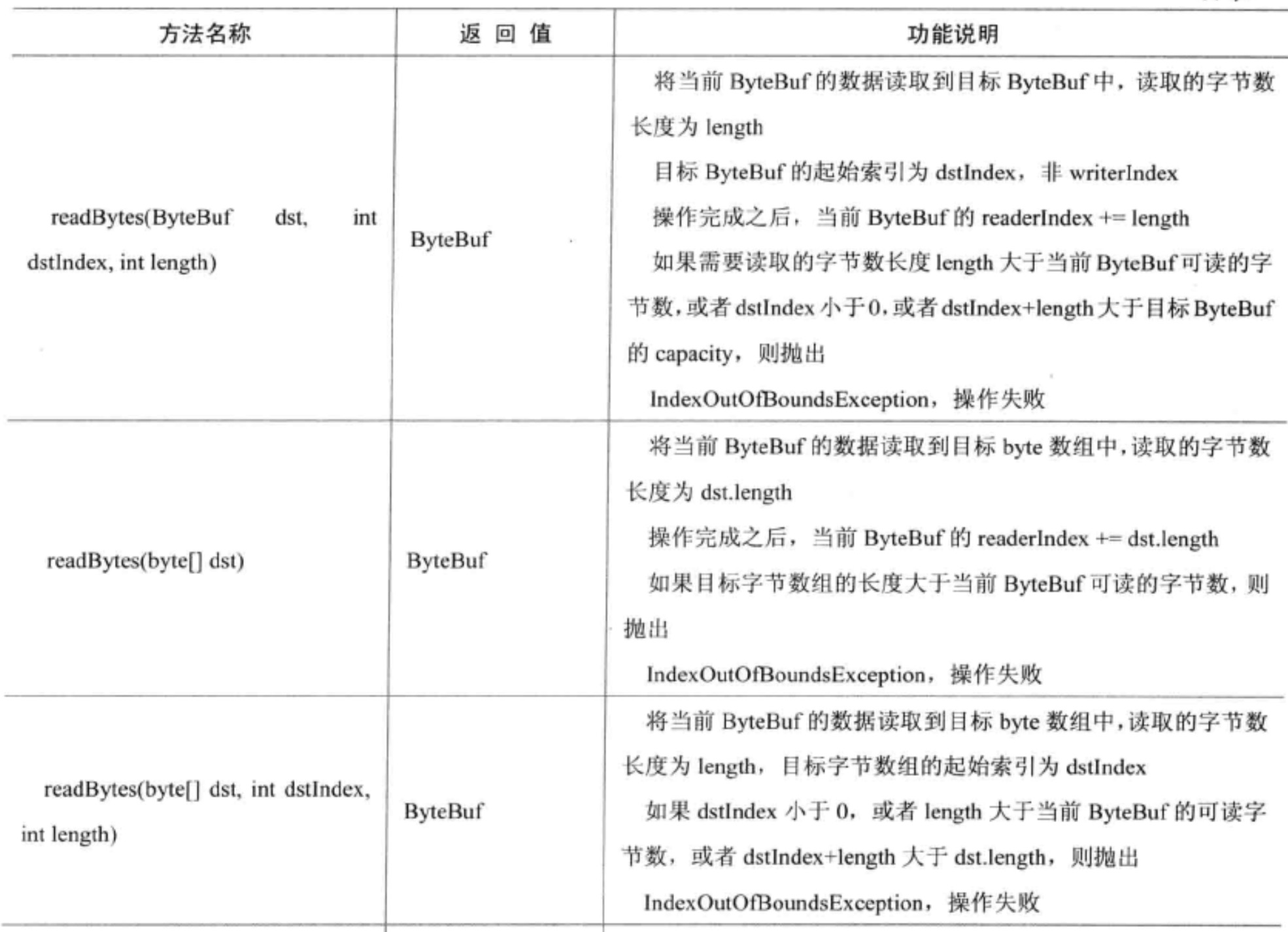
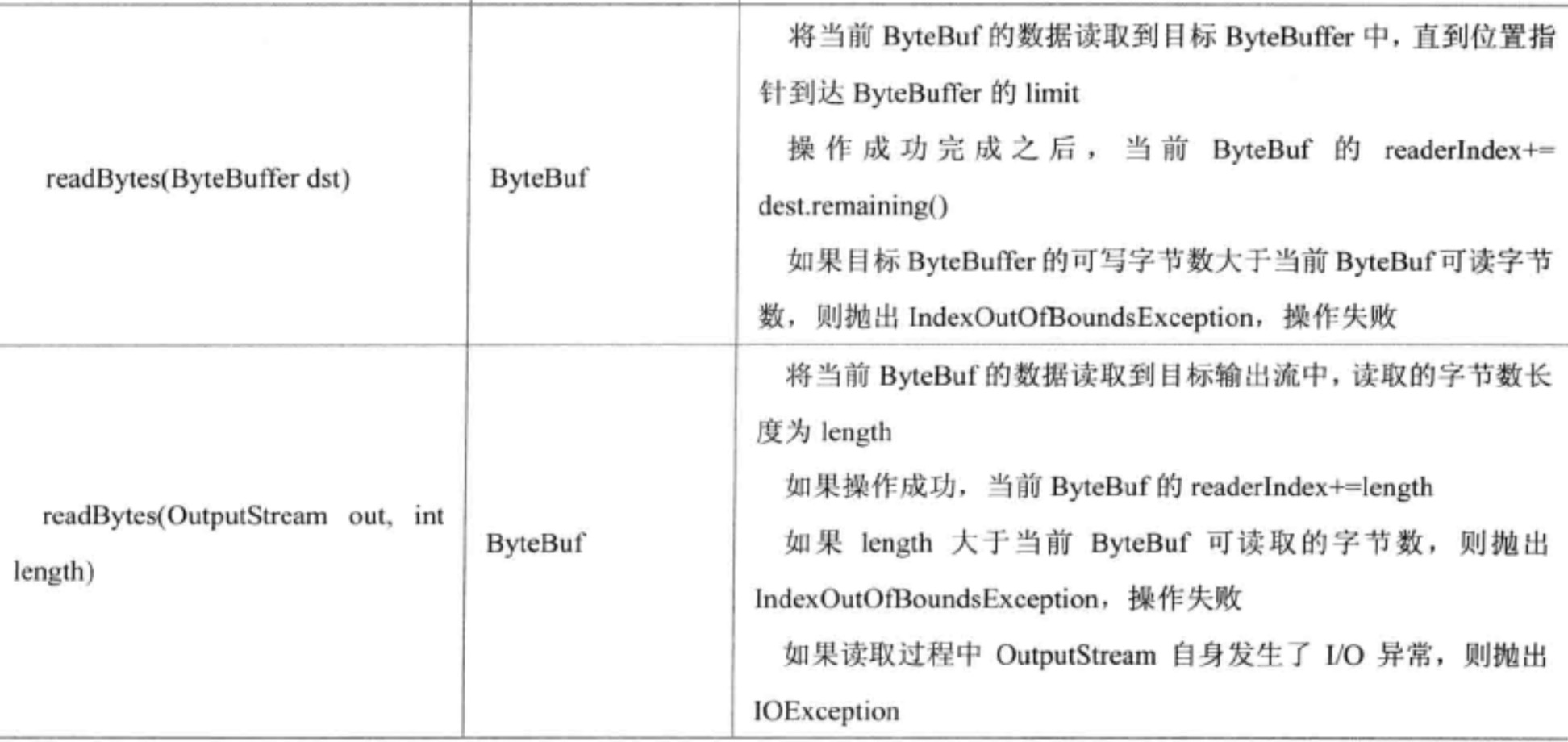
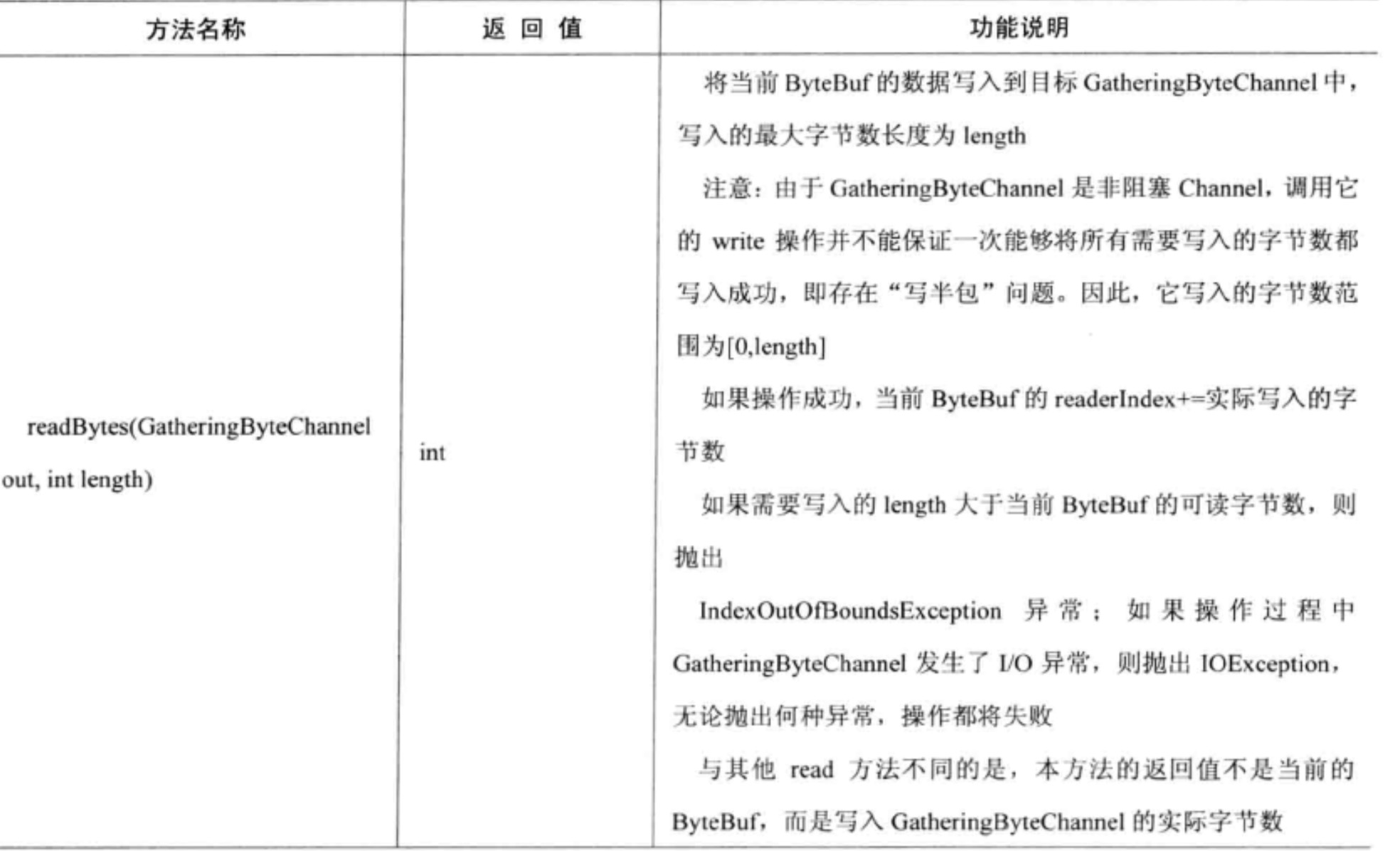
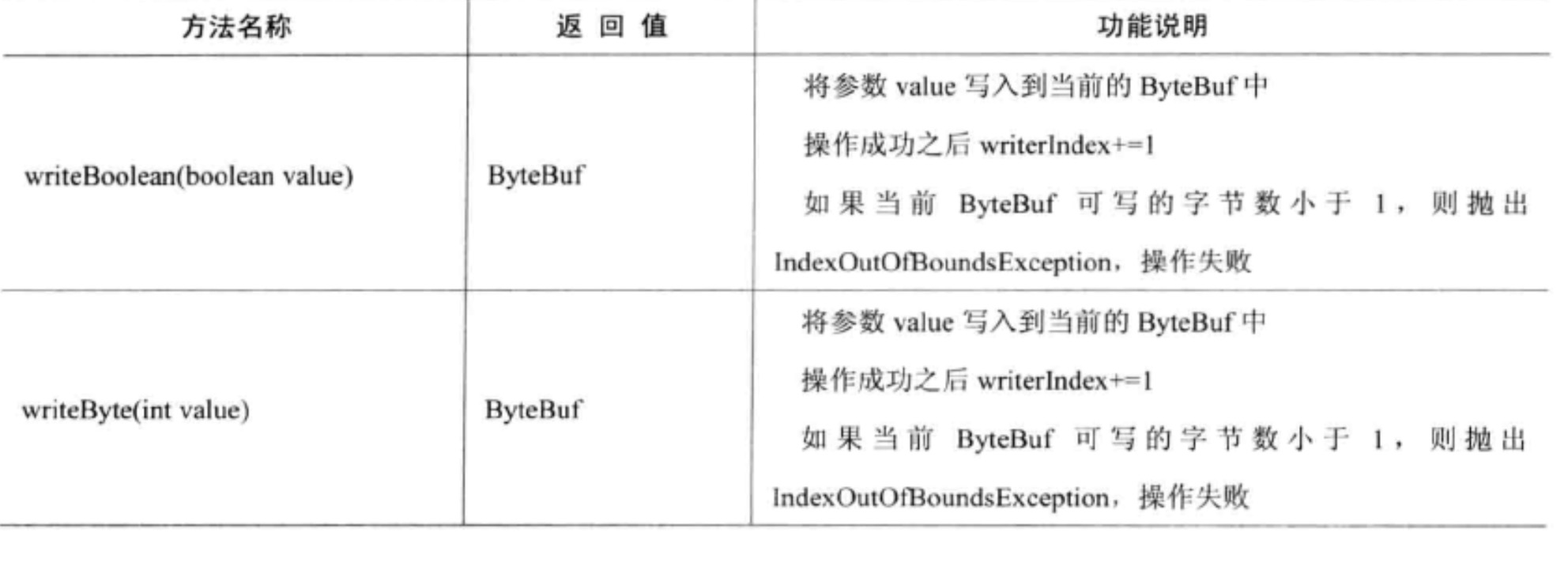
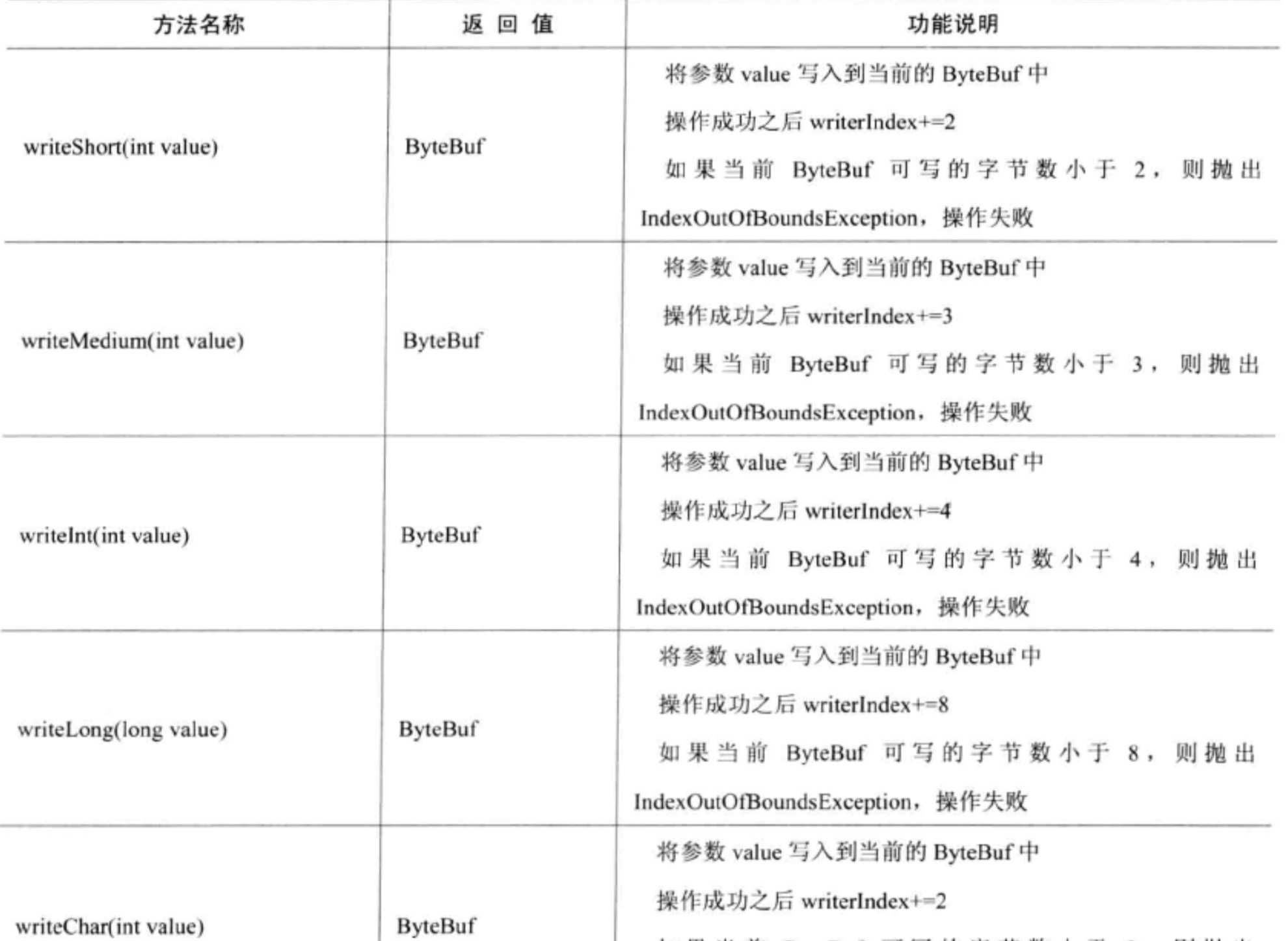
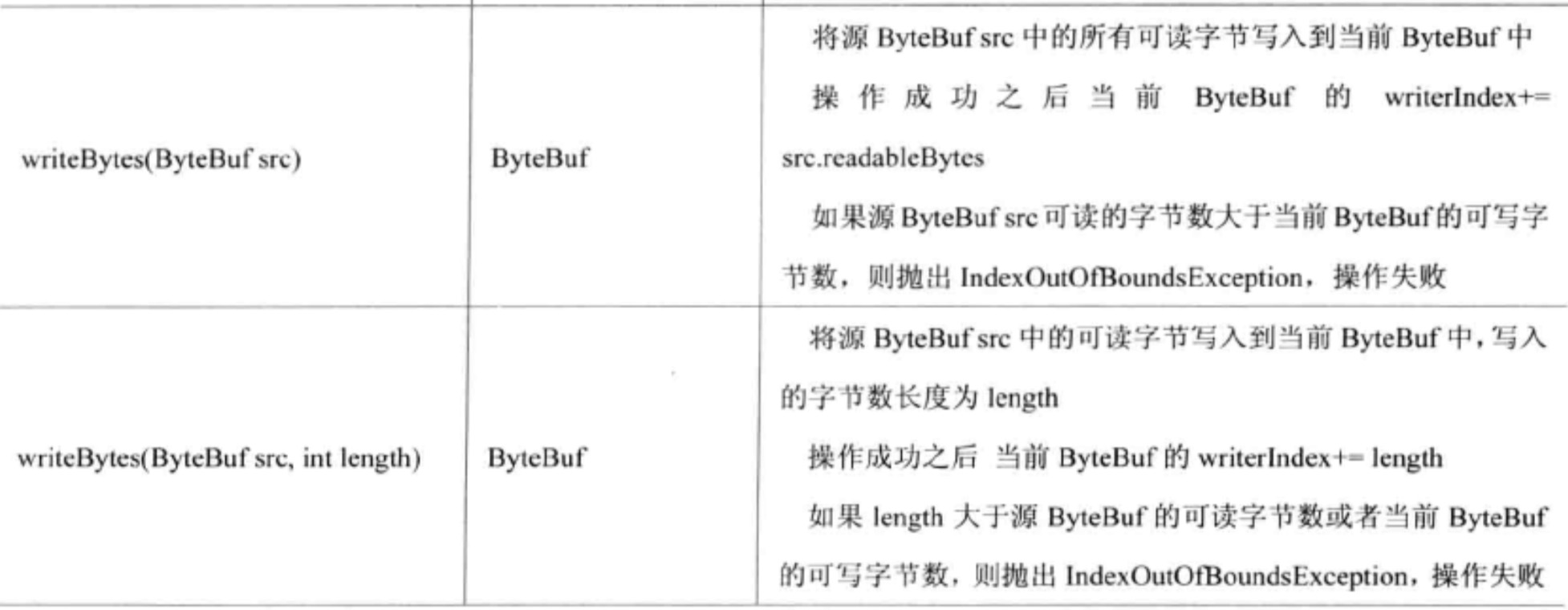
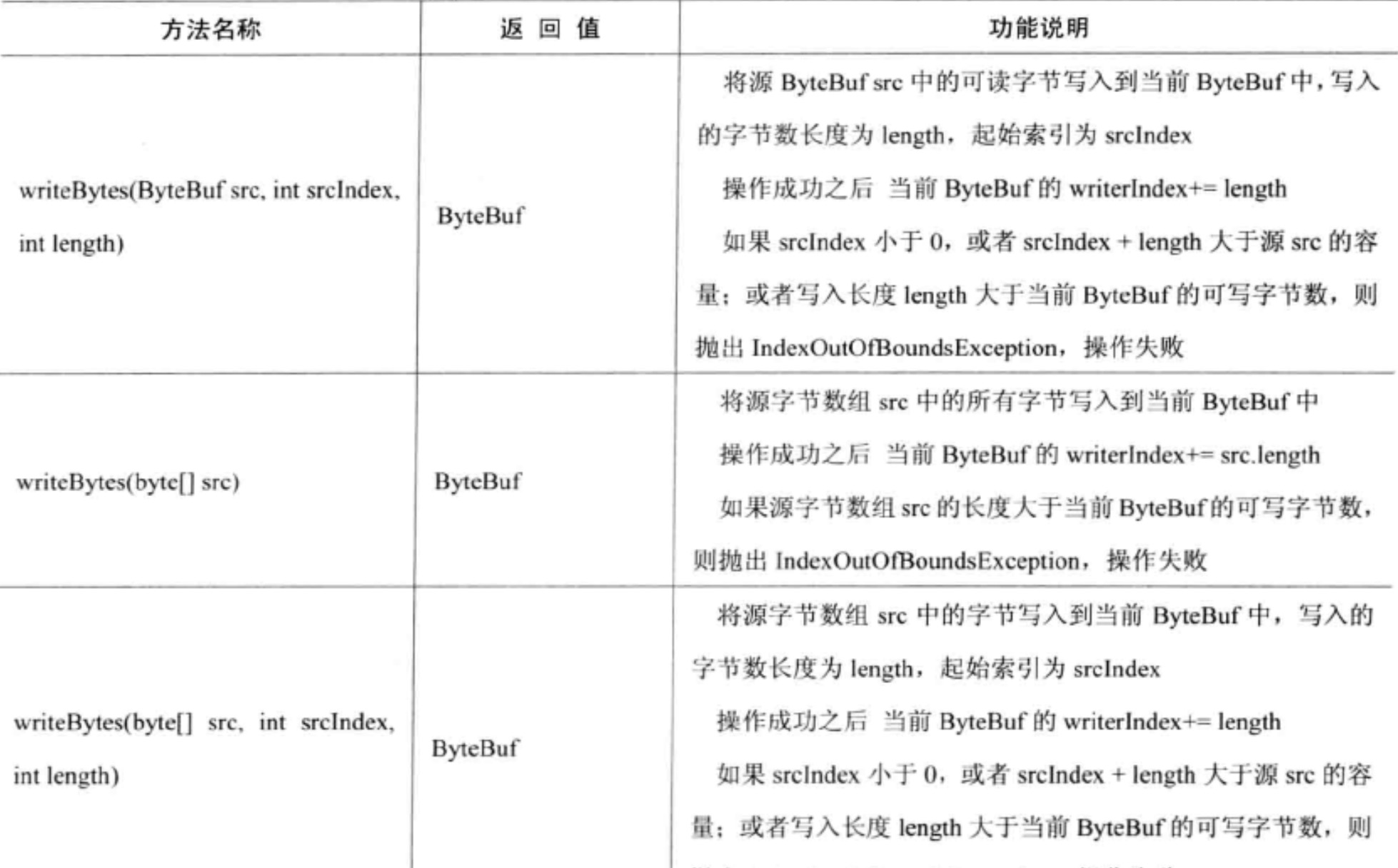
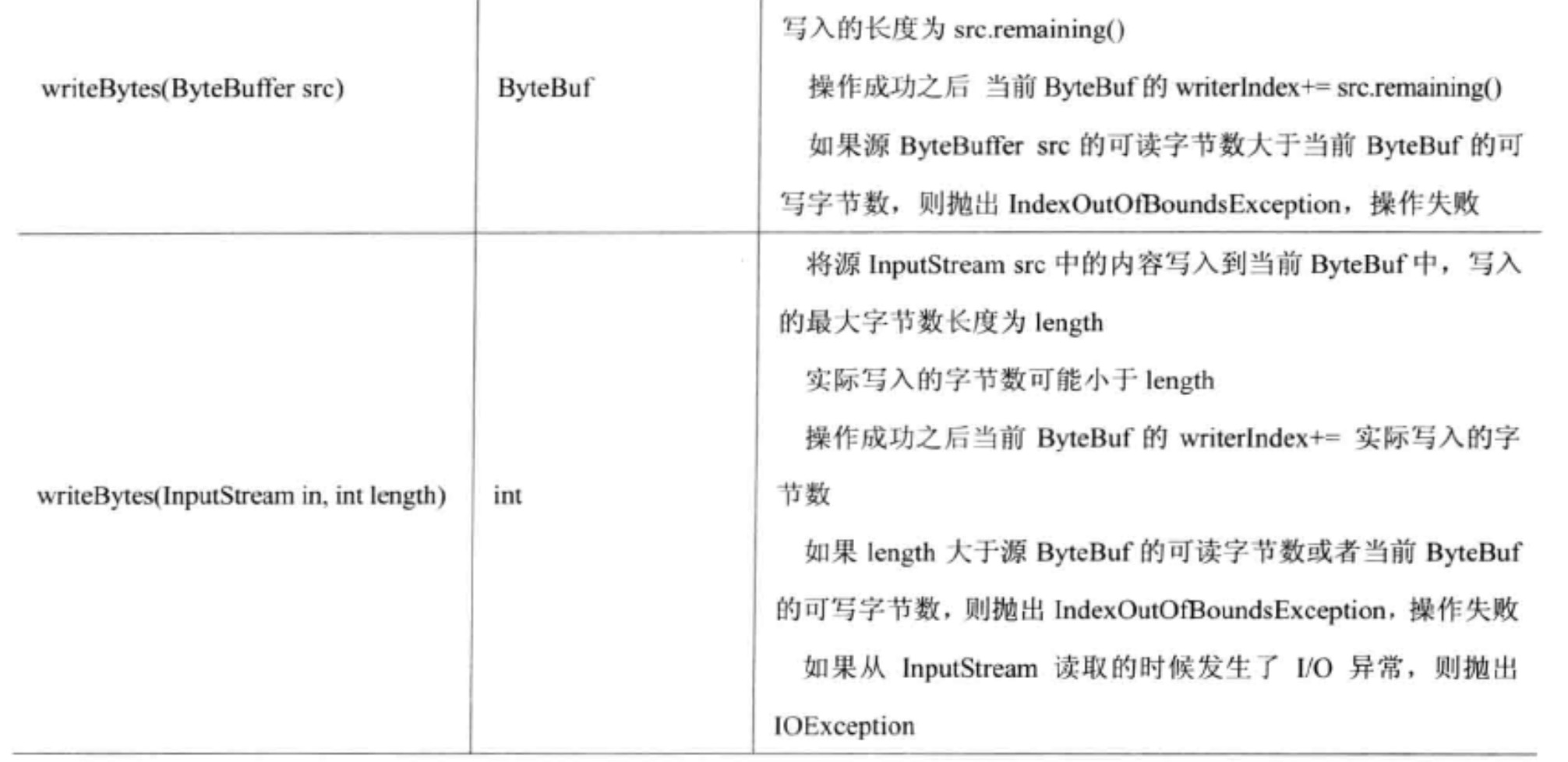
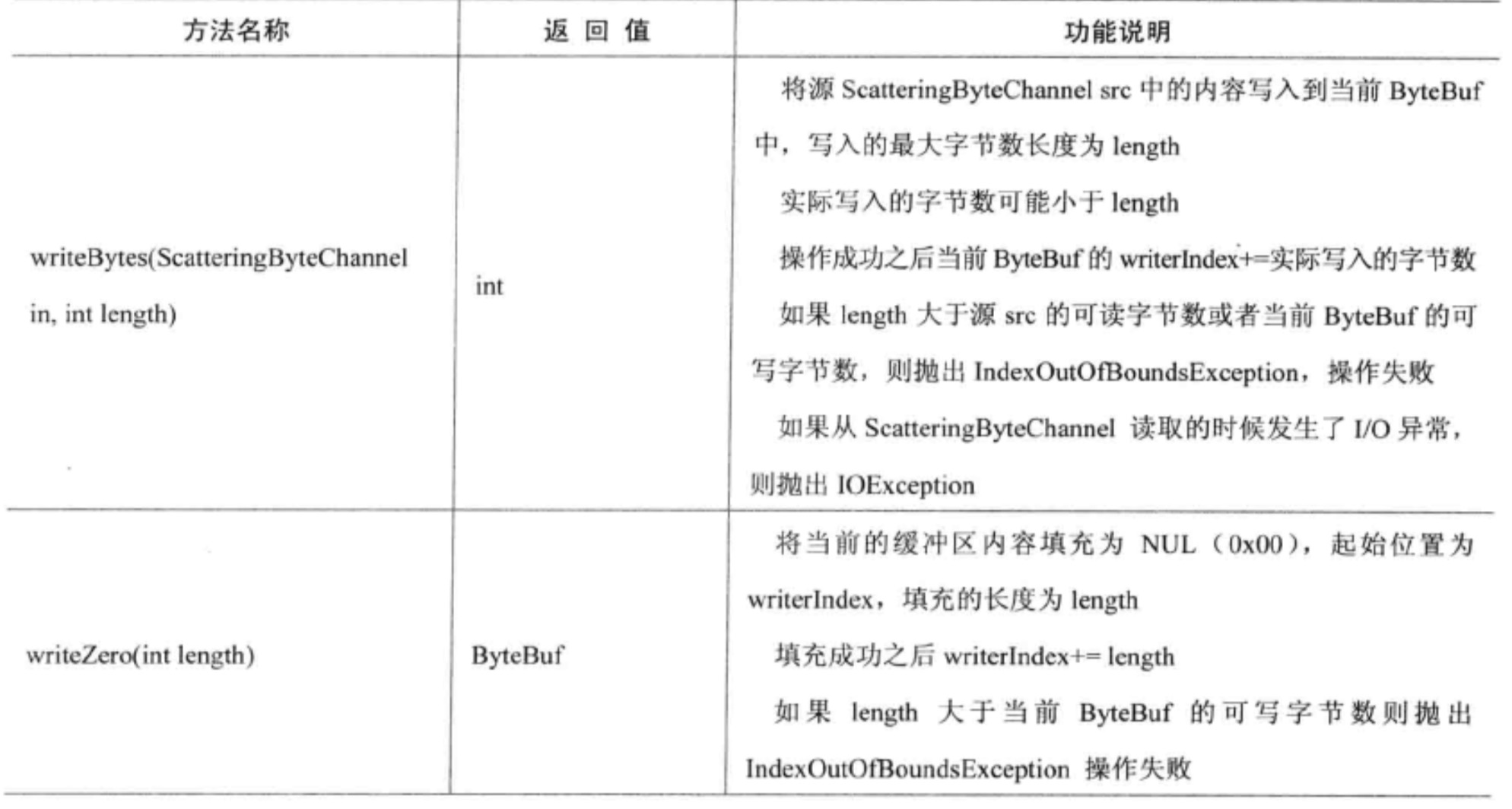
三、ByteBuf的源码分析
1.ByteBuf主要类继承关系图
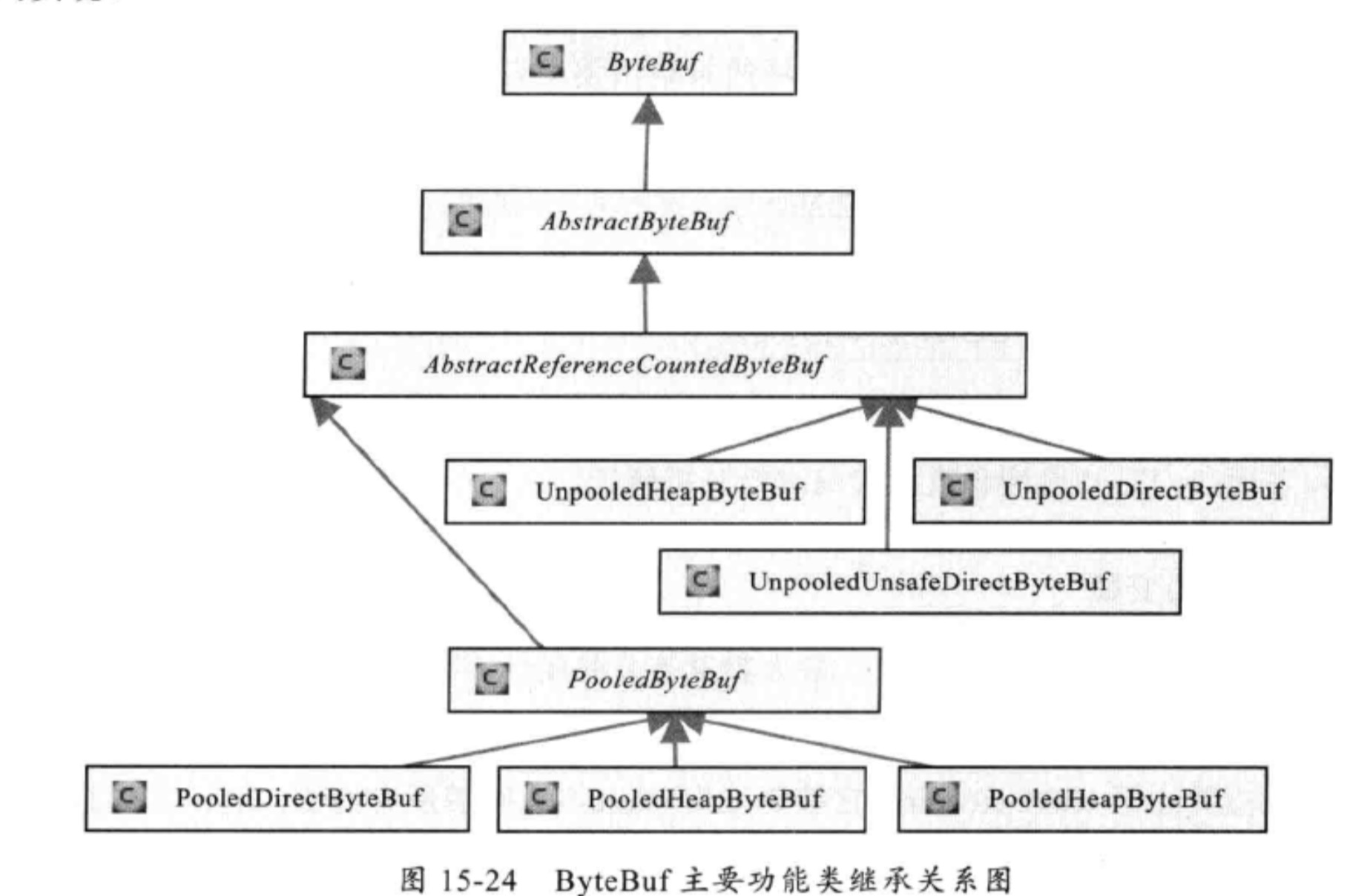
从内存分配的角度看,分2类:
ByteBuf的最佳实践是在I/O通信线程读写缓冲区使用DirectByteBuf,后端业务消息的编解码模块使用HeapByteBuf,这样组合可以达到性能最优。
从内存问收角度看,ByteBuf分为两类:基于对象池的ByteBuf和普通ByteBuf。两者的主要区別就基于对象池的ByteBuf可以重用ByteBuf对象,它自己维护了一个内存
池,可以循环利用创建的提升内存的使用效率,降低由于高负载导致的频繁GC。测试表明使用内存池后的在高负载、大并发的冲击下内存和GC更加平稳。
2.AbstractByteBuf 源码分析
(1).内部结构实现
1
2
3
4
5
6
7
|
+-------------------+------------------+------------------+
| discardable bytes | readable bytes | writable bytes |
| | (CONTENT) | |
+-------------------+------------------+------------------+
| | | |
0 <= readerIndex <= writerIndex <= capacity
|
1
2
3
4
5
6
7
8
9
10
11
12
13
14
15
16
17
18
19
20
21
22
23
24
25
26
|
public abstract class AbstractByteBuf extends ByteBuf {
private static final InternalLogger logger = InternalLoggerFactory.getInstance(AbstractByteBuf.class);
private static final String PROP_MODE = "io.netty.buffer.bytebuf.checkAccessible";
private static final boolean checkAccessible;
static {
checkAccessible = SystemPropertyUtil.getBoolean(PROP_MODE, true);
...
}
static final ResourceLeakDetector<ByteBuf> leakDetector =
ResourceLeakDetectorFactory.instance().newResourceLeakDetector(ByteBuf.class); //资源泄漏检查
int readerIndex;//读索引
int writerIndex;//写索引
private int markedReaderIndex;//标记读索引,主要用于重置作用
private int markedWriterIndex;//标记写索引,主要用于重置作用
private final int maxCapacity; //最大容量
protected AbstractByteBuf(int maxCapacity) {
if (maxCapacity < 0) {
throw new IllegalArgumentException("maxCapacity: " + maxCapacity + " (expected: >= 0)");
}
this.maxCapacity = maxCapacity;
}
}
|
(2).读操作
a. read基本类型1
- byte
1
2
3
4
5
6
7
8
9
10
11
12
13
14
15
16
17
18
19
20
21
22
23
24
25
|
@Override
public byte readByte() {
checkReadableBytes0(1); //验证readerIndex
int i = readerIndex;
byte b = _getByte(i); //_getByte是抽象方法,子类实现。这里运用模版方法模式
readerIndex = i + 1; //修改readerIndex
return b;
}
//验证读取是否越界readerIndex
private void checkReadableBytes0(int minimumReadableBytes) {
ensureAccessible();
if (readerIndex > writerIndex - minimumReadableBytes) {// 判断是否越界writerIndex
throw new IndexOutOfBoundsException...
}
}
//每个试图访问缓冲区内容的方法都应该调用它,以检查缓冲区是否在之前释放。
//checkAccessible 是访问验证,在配置中设置io.netty.buffer.bytebuf.checkAccessible,默认是true
//refCnt() 引用计数为0,说明已经释放对象
protected final void ensureAccessible() {
if (checkAccessible && refCnt() == 0) {
throw new IllegalReferenceCountException(0);
}
}
|
- 对基本类型boolean,short,int,long,char,float,double操作
1
2
3
4
5
6
7
8
9
10
11
12
13
14
15
16
17
18
19
20
21
22
23
24
25
26
27
28
29
30
31
32
33
34
35
36
37
38
39
40
41
42
43
|
@Override
public boolean readBoolean() {
return readByte() != 0;
}
//short占用2字节
@Override
public short readShort() {
checkReadableBytes0(2);
short v = _getShort(readerIndex); //_getShort 抽象方法
readerIndex += 2;
return v;
}
//int占用4字节
@Override
public int readInt() {
checkReadableBytes0(4);
int v = _getInt(readerIndex);
readerIndex += 4;
return v;
}
//long占用8字节
@Override
public long readLong() {
checkReadableBytes0(8);
long v = _getLong(readerIndex);
readerIndex += 8;
return v;
}
//char调用readShort,强转化char
@Override
public char readChar() {
return (char) readShort();
}
//float调用readInt,Float.intBitsToFloat转化float
@Override
public float readFloat() {
return Float.intBitsToFloat(readInt());
}
//double调用readInt,Double.longBitsToDouble转化double
@Override
public double readDouble() {
return Double.longBitsToDouble(readLong());
}
|
b. readBytes(byte[] dst, int dstIndex, int length)
1
2
3
4
5
6
7
|
@Override
public ByteBuf readBytes(byte[] dst, int dstIndex, int length) {
checkReadableBytes(length); //验证
getBytes(readerIndex, dst, dstIndex, length); //getBytes抽象方法
readerIndex += length;
return this;
}
|
(3).写操作
a.write基本类型
- byte
1
2
3
4
5
6
7
8
9
10
11
12
13
14
15
16
17
18
19
20
|
@Override
public ByteBuf writeByte(int value) {
ensureWritable0(1); //验证,动态扩容
_setByte(writerIndex++, value);
return this;
}
final void ensureWritable0(int minWritableBytes) {
ensureAccessible();
//writableBytes:capacity() - writerIndex
if (minWritableBytes <= writableBytes()) {//判断写的容量
return;
}
if (minWritableBytes > maxCapacity - writerIndex) {
throw new IndexOutOfBoundsException...
}
//alloc()获取ByteBufAllocator#calculateNewCapacity获取新容量大小,以及大小2次方
int newCapacity = alloc().calculateNewCapacity(writerIndex + minWritableBytes, maxCapacity); //动态扩容
// 扩容新容量
capacity(newCapacity);
}
|
为什么需要动态扩展?
很多时候都是依据经验来判断Pojo对象的大小,如果这个估计值偏大则造成内存浪费,如果偏小直接抛出异常,这种做法对用户非常不友好。
而Netty的ByteBuf支持动态扩展,为了保证安全,可以指定最大容量。
calculateNewCapacity方法AbstractByteBufAllocator抽象类实现;
1
2
3
4
5
6
7
8
9
10
11
12
13
14
15
16
17
18
19
20
21
22
23
24
25
26
27
28
29
30
31
32
|
@Override
public int calculateNewCapacity(int minNewCapacity, int maxCapacity) {
...参数验证
//CALCULATE_THRESHOLD = 1048576 * 4
final int threshold = CALCULATE_THRESHOLD; // 4 MiB page
if (minNewCapacity == threshold) {
return threshold;
}
// If over threshold, do not double but just increase by threshold.
//如果超过阈值,按阈值累加
if (minNewCapacity > threshold) {
int newCapacity = minNewCapacity / threshold * threshold;
//minNewCapacity / threshold 处理成newCapacity是threshold倍数
if (newCapacity > maxCapacity - threshold) {
newCapacity = maxCapacity;
} else {
newCapacity += threshold;
}
return newCapacity;
}
// Not over threshold. Double up to 4 MiB, starting from 64.
//不超过阈值。从64开始,以2倍扩容,增加到4Min。
int newCapacity = 64;
while (newCapacity < minNewCapacity) {
newCapacity <<= 1;
}
return Math.min(newCapacity, maxCapacity);
}
|
计算扩容新容量大小原理:
设置阀门值是4MB,如果新增的内存空间大于这个值,不采用倍增,而采用每次步进4MB的方式。如果扩容之后的新容量小于阀值,则以64进行倍增 。
为什么这样做原因?
不希望一次增加容量太小,导致需要频繁的扩容,不希望一次增加太多,造成空间上的浪费。因此,在内存比较小的时候(<4MB)的时候,倍增64->128->256字节,这种方式大多数应用可以接收
当内存达到阀值时,再倍增就会带来额外的内存浪费,例如10MB->20MB,因此使用步增的方式进行扩张。
- 写操作基本数据boolean,short,int,long,char,float,double
1
2
3
4
5
6
7
8
9
10
11
12
13
14
15
16
17
18
19
20
21
22
23
24
25
26
27
28
29
30
31
32
33
34
35
36
37
38
39
40
41
42
43
44
|
@Override
public ByteBuf writeBoolean(boolean value) {
writeByte(value ? 1 : 0);
return this;
}
@Override
public ByteBuf writeShort(int value) {
ensureWritable0(2);
_setShort(writerIndex, value);
writerIndex += 2;
return this;
}
@Override
public ByteBuf writeInt(int value) {
ensureWritable0(4);
_setInt(writerIndex, value);
writerIndex += 4;
return this;
}
@Override
public ByteBuf writeLong(long value) {
ensureWritable0(8);
_setLong(writerIndex, value);
writerIndex += 8;
return this;
}
@Override
public ByteBuf writeChar(int value) {
writeShort(value);
return this;
}
//Float.floatToRawIntBits 转化int
@Override
public ByteBuf writeFloat(float value) {
writeInt(Float.floatToRawIntBits(value));
return this;
}
//Double.doubleToRawLongBits 转化long
@Override
public ByteBuf writeDouble(double value) {
writeLong(Double.doubleToRawLongBits(value));
return this;
}
|
b. writeBytes(byte[] src, int srcIndex, int length)
1
2
3
4
5
6
7
8
|
@Override
public ByteBuf writeBytes(byte[] src, int srcIndex, int length) {
ensureWritable(length);
setBytes(writerIndex, src, srcIndex, length);//setBytes抽象方法
writerIndex += length;
return this;
}
|
(3).Discardable 丢弃已读的数据
1
2
3
4
5
6
7
8
9
10
11
12
13
14
15
16
17
18
19
20
21
22
23
24
25
26
27
28
29
30
31
32
33
34
|
@Override
public ByteBuf discardReadBytes() {
ensureAccessible();
if (readerIndex == 0) {
return this;
}
if (readerIndex != writerIndex) {
setBytes(0, this, readerIndex, writerIndex - readerIndex);//移动元素
writerIndex -= readerIndex;
adjustMarkers(readerIndex);
readerIndex = 0;
} else {
adjustMarkers(readerIndex);
writerIndex = readerIndex = 0;
}
return this;
}
//调整标记markedReaderIndex,markedWriterIndex
protected final void adjustMarkers(int decrement) {
int markedReaderIndex = this.markedReaderIndex;
if (markedReaderIndex <= decrement) {
this.markedReaderIndex = 0;
int markedWriterIndex = this.markedWriterIndex;
if (markedWriterIndex <= decrement) {
this.markedWriterIndex = 0;
} else {
this.markedWriterIndex = markedWriterIndex - decrement;
}
} else {
this.markedReaderIndex = markedReaderIndex - decrement;
markedWriterIndex -= decrement;
}
}
|
discardSomeReadBytes一个判断readerIndex >= capacity() >>> 1,就是说readerIndex大于等容量大小一半进行回收操作。
1
2
3
4
5
6
7
8
9
10
11
12
13
14
15
16
17
18
19
20
21
|
@Override
public ByteBuf discardSomeReadBytes() {
ensureAccessible();
if (readerIndex == 0) {
return this;
}
if (readerIndex == writerIndex) {
adjustMarkers(readerIndex);
writerIndex = readerIndex = 0;
return this;
}
if (readerIndex >= capacity() >>> 1) {
setBytes(0, this, readerIndex, writerIndex - readerIndex);
writerIndex -= readerIndex;
adjustMarkers(readerIndex);
readerIndex = 0;
}
return this;
}
|
(4). clear
1
2
3
4
5
6
|
@Override
public ByteBuf clear() {
readerIndex = writerIndex = 0;
return this;
}
|
(5). skipBytes
在解码的时候,有时候需要丢弃非法的数据报文。非常简单,修改readerIndex即可;
1
2
3
4
5
6
|
@Override
public ByteBuf skipBytes(int length) {
checkReadableBytes(length);
readerIndex += length;
return this;
}
|
(7).slice 返回此缓冲区的可读字节的一部分。修改返回的缓冲区或此缓冲区的内容会影响彼此的内容,同时它们维护单独的索引和标记。
1
2
3
4
5
6
7
8
9
10
|
@Override
public ByteBuf slice() {
return slice(readerIndex, readableBytes());
}
@Override
public ByteBuf slice(int index, int length) {
return new UnpooledSlicedByteBuf(this, index, length);
}
|
- 创建UnpooledSlicedByteBuf,包装当前ByteBuf,控制下标反问
2.AbstractReferenceCountedByteBuf 源码分析
从类的名字可以看出,该类的功能主要是引用计数,类似于JVM内存回收的对象引用计数器,用于跟踪对象的分配和销毁,用于自动的内存回收。
(1).内部结构
1
2
3
4
5
6
7
8
9
10
11
12
13
|
public abstract class AbstractReferenceCountedByteBuf extends AbstractByteBuf {
//CAS操作refCnt属性
private static final AtomicIntegerFieldUpdater<AbstractReferenceCountedByteBuf> refCntUpdater =
AtomicIntegerFieldUpdater.newUpdater(AbstractReferenceCountedByteBuf.class, "refCnt");
private volatile int refCnt;//引用计数
protected AbstractReferenceCountedByteBuf(int maxCapacity) {
super(maxCapacity);
refCntUpdater.set(this, 1);
}
}
|
(2).retain 添加引用计数
1
2
3
4
5
6
7
8
9
10
11
12
13
14
|
@Override
public ByteBuf retain() {
return retain0(1);
}
private ByteBuf retain0(final int increment) {
int oldRef = refCntUpdater.getAndAdd(this, increment);
if (oldRef <= 0 || oldRef + increment < oldRef) {
// Ensure we don't resurrect (which means the refCnt was 0) and also that we encountered an overflow.
//确保我们不复活(这意味着refCnt是0),并且我们遇到了溢出。
refCntUpdater.getAndAdd(this, -increment);
throw new IllegalReferenceCountException(oldRef, increment);
}
return this;
}
|
(3).release 减去引用计数
1
2
3
4
5
6
7
8
9
10
11
12
13
14
15
16
|
@Override
public boolean release() {
return release0(1);
}
private boolean release0(int decrement) {
int oldRef = refCntUpdater.getAndAdd(this, -decrement);
if (oldRef == decrement) { //说明减去refCnt为零
deallocate(); //调用deallocate方法来释放ByteBuf对象
return true;
} else if (oldRef < decrement || oldRef - decrement > oldRef) {
// Ensure we don't over-release, and avoid underflow.
refCntUpdater.getAndAdd(this, decrement);
throw new IllegalReferenceCountException(oldRef, decrement);
}
return false;
}
|
4.UnpooledHeapByteBuf 源码分析
基于堆内存,没有对象池,意味着每次I/O的读写都会创建一个新的UnpooledHeapByteBuf,频繁进行大块内存的分配和
回收可能会对性能有一定的影响,但是相比于堆外内存的申请和释放,成本还是要低一些。
相比于PooledHeapByteBuf,其原理更加的简单,也不容易出现内存管理方面的问题,因此在满足性能的情况下,推荐使用
UnpooledHeapByteBuf。
(1).内部结构
1
2
3
4
5
6
7
8
9
10
11
12
13
14
15
16
17
18
19
20
21
22
23
24
25
26
27
28
29
30
31
|
public class UnpooledHeapByteBuf extends AbstractReferenceCountedByteBuf {
private final ByteBufAllocator alloc;
byte[] array;
private ByteBuffer tmpNioBuf; //写入或者读取NIO通道,就用到这个属性
public UnpooledHeapByteBuf(ByteBufAllocator alloc, int initialCapacity, int maxCapacity) {
super(maxCapacity);
...
this.alloc = alloc;
setArray(allocateArray(initialCapacity));
setIndex(0, 0);
}
protected UnpooledHeapByteBuf(ByteBufAllocator alloc, byte[] initialArray, int maxCapacity) {
super(maxCapacity);
...
this.alloc = alloc;
setArray(initialArray);
setIndex(0, initialArray.length);
}
byte[] allocateArray(int initialCapacity) {
return new byte[initialCapacity];
}
private void setArray(byte[] initialArray) {
array = initialArray;
tmpNioBuf = null;
}
}
|
(2).capacity扩容和缩小容量操作
运用System.arraycopy赋值数组元素;
1
2
3
4
5
6
7
8
9
10
11
12
13
14
15
16
17
18
19
20
21
22
23
24
25
26
27
28
29
30
|
@Override
public ByteBuf capacity(int newCapacity) {
checkNewCapacity(newCapacity);
int oldCapacity = array.length;
byte[] oldArray = array;
if (newCapacity > oldCapacity) { //扩大容量
byte[] newArray = allocateArray(newCapacity);
System.arraycopy(oldArray, 0, newArray, 0, oldArray.length);//复制元素
setArray(newArray);
freeArray(oldArray);
} else if (newCapacity < oldCapacity) {//缩小容量
byte[] newArray = allocateArray(newCapacity);
int readerIndex = readerIndex();
if (readerIndex < newCapacity) {
int writerIndex = writerIndex();
if (writerIndex > newCapacity) {
writerIndex(writerIndex = newCapacity);
}
System.arraycopy(oldArray, readerIndex, newArray, readerIndex, writerIndex - readerIndex);
} else {
setIndex(newCapacity, newCapacity);
}
setArray(newArray);
//空方法
freeArray(oldArray);
}
return this;
}
|
(3).read基本数据byte,short,int,long
1
2
3
4
5
6
7
8
9
10
11
12
13
14
15
16
17
|
@Override
protected byte _getByte(int index) {
return HeapByteBufUtil.getByte(array, index);
}
@Override
protected short _getShort(int index) {
return HeapByteBufUtil.getShort(array, index);
}
@Override
protected int _getInt(int index) {
return HeapByteBufUtil.getInt(array, index);
}
@Override
protected long _getLong(int index) {
return HeapByteBufUtil.getLong(array, index);
}
|
最终调用HeapByteBufUtil,部分源码
1
2
3
4
5
6
7
8
9
10
11
12
13
14
15
16
17
18
19
20
21
22
23
|
static byte getByte(byte[] memory, int index) {
return memory[index];
}
static short getShort(byte[] memory, int index) {
return (short) (memory[index] << 8 | memory[index + 1] & 0xFF);
}
static int getInt(byte[] memory, int index) {
return (memory[index] & 0xff) << 24 |
(memory[index + 1] & 0xff) << 16 |
(memory[index + 2] & 0xff) << 8 |
memory[index + 3] & 0xff;
}
static long getLong(byte[] memory, int index) {
return ((long) memory[index] & 0xff) << 56 |
((long) memory[index + 1] & 0xff) << 48 |
((long) memory[index + 2] & 0xff) << 40 |
((long) memory[index + 3] & 0xff) << 32 |
((long) memory[index + 4] & 0xff) << 24 |
((long) memory[index + 5] & 0xff) << 16 |
((long) memory[index + 6] & 0xff) << 8 |
(long) memory[index + 7] & 0xff;
}
|
说明一下,byte=8位,short=2byte=16位,int=4byte=32位,long=8byte=64位;
0xff=1111 1111;上面代码只是做位移处理获取相应值;
(4).getBytes(int index, byte[] dst, int dstIndex, int length)
1
2
3
4
5
6
|
@Override
public ByteBuf getBytes(int index, byte[] dst, int dstIndex, int length) {
checkDstIndex(index, length, dstIndex, dst.length); //验证
System.arraycopy(array, index, dst, dstIndex, length);
return this;
}
|
(5).wirte基本操作 byte,short,int,long
1
2
3
4
5
6
7
8
9
10
11
12
13
14
15
16
17
18
|
@Override
protected void _setByte(int index, int value) {
HeapByteBufUtil.setByte(array, index, value);
}
@Override
protected void _setShort(int index, int value) {
HeapByteBufUtil.setShort(array, index, value);
}
@Override
protected void _setInt(int index, int value) {
HeapByteBufUtil.setInt(array, index, value);
}
@Override
protected void _setLong(int index, long value) {
HeapByteBufUtil.setLong(array, index, value);
}
|
最终调用HeapByteBufUtil,部分源码
1
2
3
4
5
6
7
8
9
10
11
12
13
14
15
16
17
18
19
20
21
22
23
|
static void setByte(byte[] memory, int index, int value) {
memory[index] = (byte) value;
}
static void setShort(byte[] memory, int index, int value) {
memory[index] = (byte) (value >>> 8);
memory[index + 1] = (byte) value;
}
static void setInt(byte[] memory, int index, int value) {
memory[index] = (byte) (value >>> 24);
memory[index + 1] = (byte) (value >>> 16);
memory[index + 2] = (byte) (value >>> 8);
memory[index + 3] = (byte) value;
}
static void setLong(byte[] memory, int index, long value) {
memory[index] = (byte) (value >>> 56);
memory[index + 1] = (byte) (value >>> 48);
memory[index + 2] = (byte) (value >>> 40);
memory[index + 3] = (byte) (value >>> 32);
memory[index + 4] = (byte) (value >>> 24);
memory[index + 5] = (byte) (value >>> 16);
memory[index + 6] = (byte) (value >>> 8);
memory[index + 7] = (byte) value;
}
|
(6).setBytes(int index, byte[] src, int srcIndex, int length)
1
2
3
4
5
6
|
@Override
public ByteBuf setBytes(int index, byte[] src, int srcIndex, int length) {
checkSrcIndex(index, length, srcIndex, src.length);
System.arraycopy(src, srcIndex, array, index, length);
return this;
}
|
5.UnpooledDirectByteBuf 源码分析
直接内存操作DirectByteBuffer类
(1).内部结构
1
2
3
4
5
6
7
8
9
10
11
12
13
14
15
16
17
18
19
20
21
22
23
24
25
26
27
28
29
30
31
32
33
34
35
36
37
38
39
40
41
42
43
44
45
46
47
48
49
50
51
52
53
|
public class UnpooledDirectByteBuf extends AbstractReferenceCountedByteBuf {
private final ByteBufAllocator alloc;
private ByteBuffer buffer;
private ByteBuffer tmpNioBuf;
private int capacity; //容量
private boolean doNotFree;
public UnpooledDirectByteBuf(ByteBufAllocator alloc, int initialCapacity, int maxCapacity) {
super(maxCapacity);
...
this.alloc = alloc;
setByteBuffer(ByteBuffer.allocateDirect(initialCapacity));
}
protected UnpooledDirectByteBuf(ByteBufAllocator alloc, ByteBuffer initialBuffer, int maxCapacity) {
super(maxCapacity);
...
int initialCapacity = initialBuffer.remaining();
...
this.alloc = alloc;
doNotFree = true;
setByteBuffer(initialBuffer.slice().order(ByteOrder.BIG_ENDIAN));
writerIndex(initialCapacity);
}
protected ByteBuffer allocateDirect(int initialCapacity) {
return ByteBuffer.allocateDirect(initialCapacity); //创建直接内存 new DirectByteBuffer(capacity)
}
/**
* Free a direct {@link ByteBuffer}
*/
protected void freeDirect(ByteBuffer buffer) {
PlatformDependent.freeDirectBuffer(buffer);
}
private void setByteBuffer(ByteBuffer buffer) {
ByteBuffer oldBuffer = this.buffer;
if (oldBuffer != null) {
if (doNotFree) {
doNotFree = false;
} else {
freeDirect(oldBuffer);
}
}
this.buffer = buffer;
tmpNioBuf = null;
capacity = buffer.remaining();
}
}
|
(2).capacity扩容或者缩小操作
1
2
3
4
5
6
7
8
9
10
11
12
13
14
15
16
17
18
19
20
21
22
23
24
25
26
27
28
29
30
31
32
33
34
|
@Override
public ByteBuf capacity(int newCapacity) {
checkNewCapacity(newCapacity);
int readerIndex = readerIndex();
int writerIndex = writerIndex();
int oldCapacity = capacity;
if (newCapacity > oldCapacity) {
ByteBuffer oldBuffer = buffer;
ByteBuffer newBuffer = allocateDirect(newCapacity);
oldBuffer.position(0).limit(oldBuffer.capacity());
newBuffer.position(0).limit(oldBuffer.capacity());
newBuffer.put(oldBuffer);
newBuffer.clear();
setByteBuffer(newBuffer);
} else if (newCapacity < oldCapacity) {
ByteBuffer oldBuffer = buffer;
ByteBuffer newBuffer = allocateDirect(newCapacity);
if (readerIndex < newCapacity) {
if (writerIndex > newCapacity) {
writerIndex(writerIndex = newCapacity);
}
oldBuffer.position(readerIndex).limit(writerIndex);
newBuffer.position(readerIndex).limit(writerIndex);
newBuffer.put(oldBuffer);
newBuffer.clear();
} else {
setIndex(newCapacity, newCapacity);
}
setByteBuffer(newBuffer);
}
return this;
}
|
不做具体说明,所有操作都是基于NIO的ByteBuffer类;
四、ByteBufAllocator
ByteBufAllocator是字节缓冲区分配器,根据Netty字节缓冲区的实现不同,分为两种不同的分配器
PooledByteBufAllocator和UnpooledByteBufAllocator。他们提供了不同ByteBuf的分配方法。
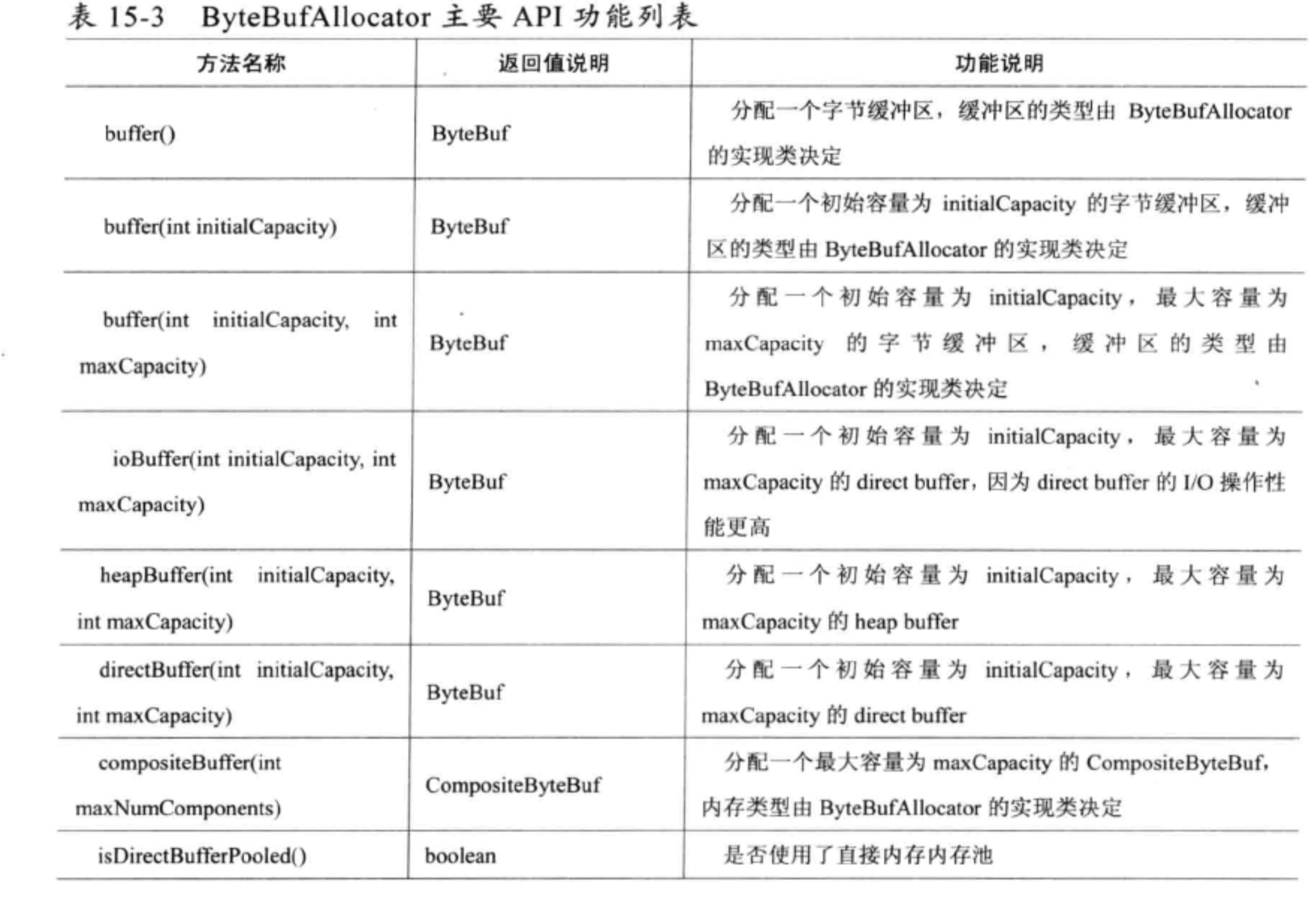
五、CompositeByteBuf 源码分析
CompositeByteBuf是一个虚拟的Buffer,它可以将多个ByteBuf组装为一个ByteBuf视图。在Java NIO中,我们有两种实现的方法:
- 将其他ByteBuffer的数据复制到一个ByteBuffer中,或者重新创建一个新的ByteBuffer,将其他的ByteBuffer复制到新建的ByteBuffer中。
- 通过容器将多个ByteBuffer存储在一起,进行统一的管理和维护。
1.数据结构
(1).Component
1
2
3
4
5
6
7
8
9
10
11
12
13
14
15
|
private static final class Component {
final ByteBuf buf;
final int length; //长度
int offset; //开始偏移量
int endOffset; //截止偏移量
Component(ByteBuf buf) {
this.buf = buf;
length = buf.readableBytes();
}
void freeIfNecessary() {
buf.release(); // 我们不应该在这里得到NPE。如果是这样,那一定是一个错误
}
}
|
(2).ComponentList继承ArrayList集合,把ByteBuf关联起来
1
2
3
4
5
6
7
8
9
10
11
12
|
private static final class ComponentList extends ArrayList<Component> {
ComponentList(int initialCapacity) {
super(initialCapacity);
}
// Expose this methods so we not need to create a new subList just to remove a range of elements.
@Override
public void removeRange(int fromIndex, int toIndex) {
super.removeRange(fromIndex, toIndex);
}
}
|
形成ComponentList结构
1
2
3
4
5
6
|
+-------------------++-------------------++-------------------+
| Component 0 || Component 1 || Component 2 |
| length=10 || length=12 || length=10 |
| offset=0 || offset=10 || offset=22 |
| endOffset=10 || endOffset=22 || endOffset=32 |
+-------------------++-------------------++-------------------+
|
2.添加对集合元素添加以及offset和endOffset赋值操作
3.删除集合元素的批量更新offset和endOffset赋值操作
1
2
3
4
5
6
7
8
9
10
11
12
13
14
15
16
17
18
19
20
21
22
23
24
25
26
27
28
29
30
31
|
public CompositeByteBuf removeComponent(int cIndex) {
checkComponentIndex(cIndex);
Component comp = components.remove(cIndex);
comp.freeIfNecessary();
if (comp.length > 0) {
// Only need to call updateComponentOffsets if the length was > 0
updateComponentOffsets(cIndex);
}
return this;
}
private void updateComponentOffsets(int cIndex) {
int size = components.size();
if (size <= cIndex) {
return;
}
Component c = components.get(cIndex);
if (cIndex == 0) {
c.offset = 0;
c.endOffset = c.length;
cIndex ++;
}
for (int i = cIndex; i < size; i ++) {
Component prev = components.get(i - 1);
Component cur = components.get(i);
cur.offset = prev.endOffset;
cur.endOffset = cur.offset + cur.length;
}
}
|














